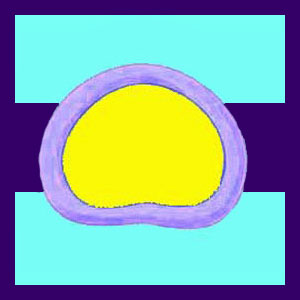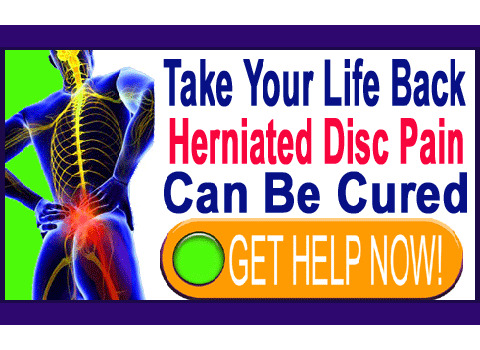
Disc pain is a colloquial diagnostic conclusion used to explain symptoms from a wide range of intervertebral disc pathologies, especially in the neck or low back. However, the discs themselves are rarely the actual source of suffering, but may be the causative mechanism that enacts pain in surrounding nerves.
There is considerable controversy whether discs can even experience pain and whether they can create the vast variety of symptoms often blamed on them. Discs are certainly the most maligned spinal structure. They are also used as a back pain scapegoat more than any other spinal condition.
Degeneration, bulging, herniation, rupture, extrusion, sequestration are all possible to experience in the spinal discs and these processes may or may not be symptomatic, depending on their location, severity or related effects on neurological tissues.
Disc Pain Truths
Discs do not contain any internal nerve endings. They are simply viscous capsules of mostly water, collagen and proteoglycans. The moisture content in discs changes continuously based on activity level, time of day, age and other circumstances.
The actual spinal discs are incapable of experiencing any pain. However, the cartilaginous end plates that provide the disc oxygen and nourishment do contain nerve tissue and can provide pain signals. Why these areas of cartilage would suddenly become painful is not completely understood. When these cartilaginous plates are the suspected cause of pain, the condition is called discogenic pain. In many patients, the tiny nerves are suspected of growing into the actual disc itself and becoming irritated due to certain proteins contained therein.
Discs might also cause pain in surrounding tissue by leaking proteins that are thought to be an irritant to nerve fibers. This protein can be expelled from the disc due to a herniation and subsequent rupture.
Proteins can also leak out as the disc dehydrates, shrinks and loses the structural integrity of the outer disc wall, called the annulus fibrosus. Disc dehydration is a completely normal part of the aging process. Proteins which escape from the nucleus pulposus are theorized to irritate surrounding neurological tissue by the process known as chemical radiculitis.
Disc Pain Statistics
Almost all adults have dehydrated discs. This process is usually well underway by the age of 30 in the lumbar and sometimes cervical spinal regions.
Many people have herniated discs. The majority have never been diagnosed and the individual is unaware of the condition. They have no pain and suffer no symptoms. These disc abnormalities are often diagnosed far in the future, during an imaging study for a completely unrelated condition. It is often discovered that the herniation has already calcified, showing that the condition has existed for many years.
Disc abnormalities are completely normal. They should actually be called normalities. The majority of disc related problems, such as degeneration and herniation, are rarely symptomatic. Most of the time, these conditions get the blame for back pain when they coincidentally exist in the area experiencing the symptoms. This misdiagnosis is one of the prime reasons for the perpetuation of the back pain epidemic.
Disc-Related Pain Reality
Most disc problems might be painful for a short time, but are unlikely to cause chronic back pain.
Herniated discs can cause serious spinal problems, but it is rare. A disc that ruptures into nerve tissue can cause serious neurological effects, such as cauda equina syndrome. These serious disc related complications are the overwhelming minority of cases, not the general rule.
Disc issues can cause spinal stenosis, particularly when paired with other canal narrowing concerns at the same level. Spinal arthritis and ligamentum flavum hypertrophy are 2 of the most common co-contributors.
Disc pathologies can also reduce the space of the neuroforaminal openings, potentially causing a compressive neuropathy to exist.
Solutions for Spinal Disc Pain
Degenerative disc disease is not a valid diagnosis to explain most back pain syndromes. Of course, our discs degenerate as a normal part of the aging process. This is not a problem, nor is it an unexpected condition.
If disc degeneration was responsible for back ache, then we would all have identical expressions of symptoms at a given age. This is simply not the case. Back pain is rampant, but the symptoms, locations and severities do not always correspond with the majority of diagnosed causes.
The most logical explanation is that most dorsalgia is caused by some other physical or psychosomatic pain process. Like many other aspects of illness and disease, medical science has a long way to go before it can combat dorsopathy effectively. Let’s hope that doctors broaden their horizons and start to incorporate more mindbody medicine into their practices. Let’s also hope that many of the coincidental and innocent scapegoat issues found in routine imaging stop taking the blame for disc pain, forcing patients to pursue treatment needlessly.
Better diagnostic protocols need to be formulated and better therapy results must be provided. Until that time comes, all doctors working in the back care sector must do their part to stop the unjust vilification of normal spinal aging, particularly in the intervertebral discs.





